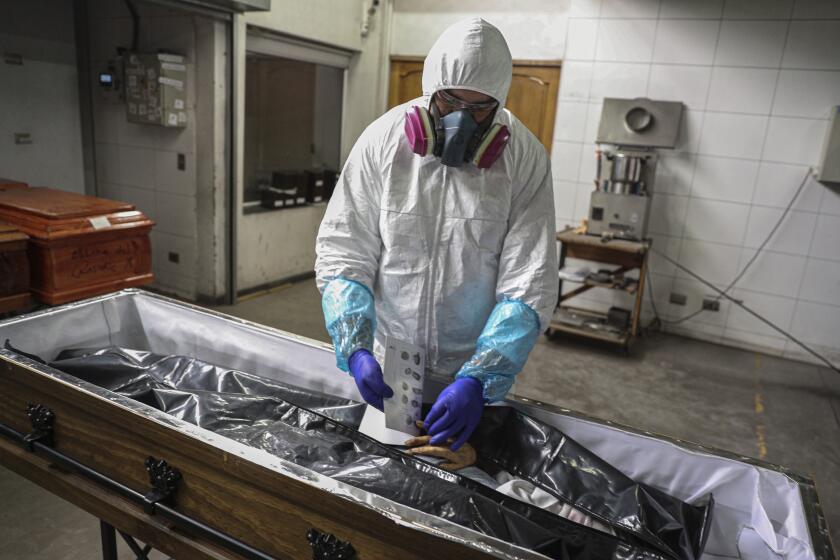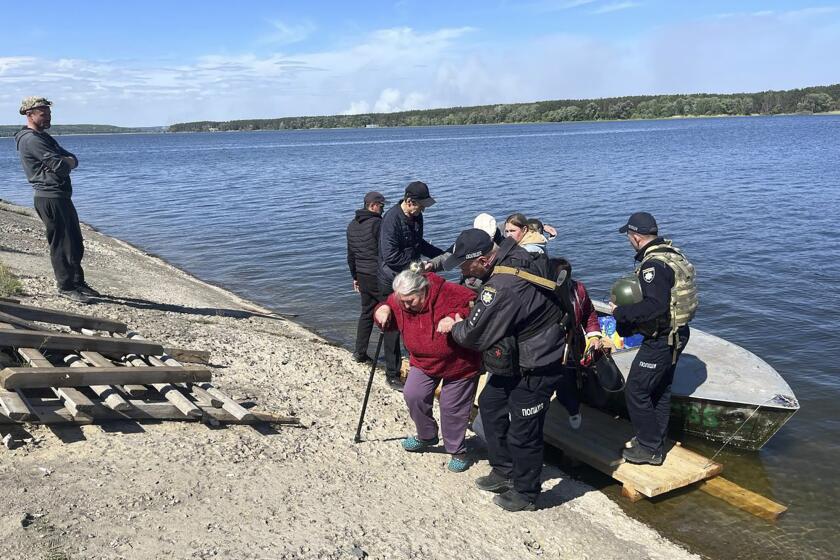Tactics in the Carpal Tunnel War
A hundred years ago, before there were such things as computers or checkout scanners or high-tech assembly lines, doctors identified a disorder called carpal tunnel syndrome.
No one imagined at the time that what was then a rare condition would become a widespread problem by the 1990s. Nor could anyone have foreseen the controversy that would ensue when workers began claiming that their injuries were job-related.
The syndrome, characterized by pain, numbness and weakness in the wrist and hand, first appeared in women who spent a lot of time crocheting, knitting and sewing. It is caused by a buildup of pressure in the carpal tunnel, a passageway in the small bones of the wrist through which crucial tendons, blood vessels and the median nerve connect to the hand.
When the nerve is compressed, the hand “goes to sleep” and sometimes doesn’t wake up. Most often, the pressure is the result of swelling in the tenosynovium, or lining of the nine major tendons passing through the carpal tunnel.
These days, carpal tunnel syndrome is most prevalent in workers who spend long stretches of their day at computer keyboards, checkout clerks who must use a repetitive wrist motion to register purchases on the scanner, assemblers who put together small electronic or other components, and meat cutters. Dentists and surgeons are being diagnosed with it, as are court reporters and attorneys.
Other patients develop the syndrome as a result of leisure activities such as golf or tennis.
“It’s exploding before our very eyes,” says orthopedic hand surgeon Charles Resnick of Arcadia, one of the doctors who developed the latest surgical treatment for the disorder. “I’m seeing five to 10 virgin carpal tunnel cases a week. I wouldn’t call it an epidemic, but it is endemic in certain regions, such as Southern California, that have a lot of white-collar industry.”
Alan Strizak of Tustin, an orthopedic surgeon, also performs the new technique in cases where he feels it is appropriate. He also is seeing a growing number of carpal tunnel patients.
In some businesses, Strizak says, carpal tunnel cases sweep through an office or factory floor “almost like the flu.”
As carpal tunnel syndrome becomes better known, Resnick says, those afflicted with it are more likely to seek treatment, “rather than just thinking it’s tendinitis and waiting for it to go away.”
Many employers are trying to prevent the problem with ergonomic work stations and training for those workers most at risk.
The controversy surrounding carpal tunnel syndrome begins with diagnosis.
“It’s not always a black and white issue,” Strizak says. “A patient can come in with classic signs of carpal tunnel syndrome, and yet, because it’s kind of a cyclical problem, the tests may not all be positive.”
Resnick says as many as one in four patients who undergo the standard test for the disorder, a nerve conduction velocity test, will show no sign of the disorder. Although newer, more sensitive tests are being tried, they are often painful and expensive and don’t show consistent results.
It’s possible, the doctors say, for a patient to fake carpal tunnel syndrome.
“I’ve had some patients who’ve used it as a dodge,” Resnick says. “But you can’t look at everyone with a jaundiced eye. You just hope to God that a person who gets surgery really needs it.”
Depending on the kind of surgery that’s done, doctors don’t always get to examine the affected area to confirm their diagnosis.
But deceptive employees aren’t the only problem.
“It goes both ways,” Resnick says. “You also get employers who say, ‘You don’t have it’ ” to all their employees who complain.
“The hot question in the field of hand surgery is, does the job cause carpal tunnel syndrome? Is there an absolute correlation? No one knows,” Resnick says. “But job activities can aggravate the condition, and depending on the state you live in, you could be compensated.” (California does allow compensation for work-related carpal tunnel syndrome.)
“Activities that require constant repetitive wrist bending and finger bending are prone to aggravate carpal tunnel syndrome,” Resnick says.
Other factors also can contribute to the problem, the doctors say. Diabetes, alcoholism, arthritis and even pregnancy can make the syndrome more likely to occur.
For Ivan Lewis of Fountain Valley, at least two factors were involved: his job and his hobby. Lewis was a butcher for many years, and he’s also an avid golfer.
“My hand would fall asleep, and I couldn’t wake it up,” he says. “Or I’d drop my fork while I was eating. I’d read about carpal tunnel syndrome, so I figured that was what it was.”
Lewis underwent surgery for his carpal tunnel syndrome. The first operation, three years ago, was a traditional open carpal tunnel release operation, first performed in 1941.
In the open procedure, doctors open the hand from the center of the palm to just above the wrist, then cut one of the ligaments that hold the wrist bones together. The idea is to enlarge the carpal tunnel and reduce the pressure on the nerve.
Two months ago, Resnick performed surgery on Lewis’ other hand, this time using a less-invasive method known as endoscopic carpal tunnel release. Using a pencil-sized device attached to a video camera inserted through two small incisions in the palm and wrist.
Treatments for the syndrome vary widely, Strizak says, and don’t necessarily always involve surgery. “Every doctor’s a little different in how they manage it.”
In most cases, the first step is a wrist splint, worn during sleep or during activities that aggravate the problem.
In 80% of cases, Resnick says, the condition worsens after sleep because the wrist relaxes and puts more pressure on the nerve.
Some doctors also use anti-inflammatory drugs, injections of corticosteroids, or physical therapy. Strizak says he’s had some success with mild diuretics in some cases, to reduce the amount of fluid in the tunnel.
Resnick first performed the endoscopic, or closed, form of carpal tunnel surgery three years ago. He’d been practicing it on cadavers, “but then I got a patient who put me up against the wall. She said, ‘Look, I’m an executive. I can’t take time off from work for this. I’ll be your first patient for this.’ I did the surgery on a Monday afternoon, and she was back to work Wednesday morning.”
By contrast, the open surgery can require up to six weeks for recuperation.
Lewis, who’s had both types, says he prefers the closed procedure. “The other one is a mess. You have to wear a plastic bag on your arm when you take a shower. But the latest surgery was much easier. I was playing golf 17 days later.”
He says his only complaint is that his golf score hasn’t gone down, “but that’s not because of my hand. It’s because I’m a lousy golfer.”
Strizak says the trend is toward less invasive surgeries. “The advantage to the more limited surgeries is that people have much less soreness and they get back to work more quickly. But the other side is that you can’t look at the nerve, which is a problem if there’s some other kind of unusual pathology. And there’s also a risk of cutting tendons and nerves because you have such a small area of visualization with the scope.”
Unlike arthroscopic surgery for the knee or shoulder, doctors aren’t able to explore the wrist and look for problems with the endoscopic technique.
In the open surgery, he says, the surgeon is able to examine the nerve and surrounding tissue. Accidents are also less likely, “but you do get some people who cut tendons and nerves they’re not meaning to cut.”
In any case, Resnick says, it’s important to treat the syndrome to prevent long-term damage. “Some surgeons feel that once you have it, it’s never going to go away, even though the symptoms may lessen. You can have atrophy of the small muscles of the hand, and around the base of the thumb. And if it’s been going on for a long time, that may not be reversible even after surgery.”
More to Read
Start your day right
Sign up for Essential California for news, features and recommendations from the L.A. Times and beyond in your inbox six days a week.
You may occasionally receive promotional content from the Los Angeles Times.






